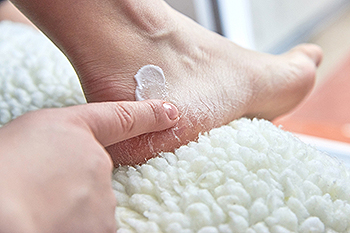Connect With Us
Blog
Items filtered by date: September 2023
Causes and Relief Solutions For Flat Feet Pain

Flat feet, also known as fallen arches, can be a source of persistent discomfort and pain for many individuals. This common condition occurs when the arches of the feet collapse, causing the entire sole to make contact with the ground. Understanding the root causes of flat feet pain is the first step toward finding effective solutions. One primary cause of flat feet pain is genetics. If you have a family history of flat feet, you are more likely to develop them. Additionally, injuries or overuse can contribute to the development of flat feet over time. Obesity and pregnancy can also put excess strain on the arches, exacerbating the condition. The good news is that flat feet pain can often be managed and relieved. Wearing footwear with proper arch support can significantly reduce discomfort. Stretching and strengthening exercises may help improve foot and leg muscle function, offering relief from pain associated with flat feet. In more severe cases, medical intervention or surgery may be considered. If you have flat feet, it is suggested that you consult a podiatrist who may prescribe custom orthotic inserts, which can provide tailored support.
Flatfoot is a condition many people suffer from. If you have flat feet, contact Eugene Little, DPM from Foot and Ankle Centers of Ohio. Our doctor will treat your foot and ankle needs.
What Are Flat Feet?
Flatfoot is a condition in which the arch of the foot is depressed and the sole of the foot is almost completely in contact with the ground. About 20-30% of the population generally has flat feet because their arches never formed during growth.
Conditions & Problems:
Having flat feet makes it difficult to run or walk because of the stress placed on the ankles.
Alignment – The general alignment of your legs can be disrupted, because the ankles move inward which can cause major discomfort.
Knees – If you have complications with your knees, flat feet can be a contributor to arthritis in that area.
Symptoms
- Pain around the heel or arch area
- Trouble standing on the tip toe
- Swelling around the inside of the ankle
- Flat look to one or both feet
- Having your shoes feel uneven when worn
Treatment
If you are experiencing pain and stress on the foot you may weaken the posterior tibial tendon, which runs around the inside of the ankle.
If you have any questions please feel free to contact our office located in Sidney, OH . We offer the newest diagnostic and treatment technologies for all your foot and ankle needs.
Managing Foot Pain

The management of foot pain is extremely individualized, depending on its cause. Patients typically combine non-pharmaceutical methods with medications for relief. Performing specific exercises that maintain muscle strength and flexibility can help to prevent future injuries. Podiatrists are essential and can offer orthotics tailored to each patient's needs. These insoles, rigid or soft, alleviate walking or running discomfort. Medications come in various forms including oral analgesics and corticosteroid injections to help control inflammation. In severe cases hindering mobility, surgery may be necessary, such as fracture repair, arthroscopic debridement, or joint fusion. Post-surgery rehabilitation and follow-up appointments are crucial for a successful recovery. If you are suffering from chronic foot pain, or if it becomes worse, it is suggested that you make an appointment with a podiatrist for a proper diagnosis and individualized treatment.
Foot Pain
Foot pain can be extremely painful and debilitating. If you have a foot pain, consult with Eugene Little, DPM from Foot and Ankle Centers of Ohio. Our doctor will assess your condition and provide you with quality foot and ankle treatment.
Causes
Foot pain is a very broad condition that could be caused by one or more ailments. The most common include:
- Bunions
- Hammertoes
- Plantar Fasciitis
- Bone Spurs
- Corns
- Tarsal Tunnel Syndrome
- Ingrown Toenails
- Arthritis (such as Gout, Rheumatoid, and Osteoarthritis)
- Flat Feet
- Injury (from stress fractures, broken toe, foot, ankle, Achilles tendon ruptures, and sprains)
- And more
Diagnosis
To figure out the cause of foot pain, podiatrists utilize several different methods. This can range from simple visual inspections and sensation tests to X-rays and MRI scans. Prior medical history, family medical history, and any recent physical traumatic events will all be taken into consideration for a proper diagnosis.
Treatment
Treatment depends upon the cause of the foot pain. Whether it is resting, staying off the foot, or having surgery; podiatrists have a number of treatment options available for foot pain.
If you have any questions, please feel free to contact our office located in Sidney, OH . We offer the newest diagnostic and treatment technologies for all your foot care needs.
Requirements to Become a Podiatrist

Becoming a podiatrist, who is a specialized medical professional focusing on foot and ankle health, involves a well-defined educational journey. An interested student will typically need to complete a bachelor's degree in a related field, such as biology or premed. After this foundation, a Doctor of Podiatric Medicine, or DPM, degree is obtained, which is a comprehensive four-year program. During the DPM program, the subjects studied can include anatomy, physiology, and podiatric medicine, accompanied by clinical training. This phase will provide hands-on experience and exposure to various foot and ankle conditions. Following graduation, the competent student will likely complete a residency program, which can last from two to four years, focusing on specialized areas, such as surgery or sports medicine. The final step is to obtain licensure by passing state-specific exams. Becoming a podiatrist requires dedication, a strong educational foundation, and a commitment to promoting foot health. If you have questions about the field of podiatry, it is suggested that you confer with a podiatrist who can provide you with pertinent information.
If you are experiencing pain in the feet or ankles, don’t join the stubborn majority refusing treatment. Feel free to contact Eugene Little, DPM from Foot and Ankle Centers of Ohio. Our doctor can provide the care you need to keep you pain-free and on your feet.
What Is a Podiatrist?
Someone would seek the care of a podiatrist if they have suffered a foot injury or have common foot ailments such as heal spurs, bunions, arch problems, deformities, ingrown toenails, corns, foot and ankle problems, etc.
Podiatric Treatment
A podiatrist will treat the problematic areas of the feet, ankle or lower leg by prescribing the following:
- Physical therapy
- Drugs
- Orthotic inserts or soles
- Surgery on lower extremity fractures
A common podiatric procedure a podiatrist will use is a scanner or force plate which will allow the podiatrist to know the designs of orthotics. Patients are then told to follow a series of tasks to complete the treatment. The computer will scan the foot a see which areas show weight distribution and pressure points. The podiatrist will read the analysis and then determine which treatment plans are available.
If you have any questions please feel free to contact our office located in Sidney, OH . We offer the newest diagnostic and treatment technologies for all your foot and ankle needs.
Reminder: When Was the Last Time...?
What Are the Symptoms, Causes, and Care For Cracked Heels?

Cracked heels are a common foot ailment, and can cause severe pain while walking. Severely cracked heels are known as heel fissures and can occur when the skin on the heels becomes excessively dry, causing them to lose their elasticity. The various causes can range from dehydration and prolonged standing to wearing open-backed footwear that fails to provide proper support. Symptoms often include visible cracks, itching, redness, and discomfort. Fortunately, there are effective relief methods available. Regular moisturization, especially with thick creams containing urea, can help to keep the skin supple. Pumice stone exfoliation and gentle scrubbing can remove dead skin, aiding in prevention. In severe cases, professional help from a podiatrist may be needed, including applying prescription creams or ointments that can help accelerate healing. Cracked heels demand attention, but with care and consistent treatment, soft, pain-free feet are well within reach. If you have developed cracked heels, it is suggested that you speak with a podiatrist who can help you manage this condition.
Cracked heels are unsightly and can cause further damage to your shoes and feet. If you have any concerns, contact Eugene Little, DPM from Foot and Ankle Centers of Ohio. Our doctor can provide the care you need to keep you pain-free and on your feet.
Cracked Heels
Cracked heels appear unappealing and can make it harder for you walk around in sandals. Aside from looking unpleasant, cracked heels can also tear stockings, socks, and wear out your shoes. There are several methods to help restore a cracked heel and prevent further damage.
How Do You Get Them?
Dry skin is the number one culprit in creating cracked heels. Many athletes, walkers, joggers, and even swimmers suffer from cracked heels. Age and skin oil production play a role to getting cracked heels as well.
Promote Healing
Over the counter medicines can help, especially for those that need instant relief or who suffer from chronic dry feet.
Wear Socks – Wearing socks with medicated creams helps lock in moisture.
Moisturizers – Applying both day and night will help alleviate dryness which causes cracking.
Pumice Stones – These exfoliate and remove dead skin, which allows for smoother moisturizer application and better absorption into the skin.
Change in Diet
Eating healthy with a well-balanced diet will give the skin a fresh and radiant look. Your body responds to the kinds of food you ingest. Omega-3 fatty acids and zinc supplements can also revitalize skin tissue.
Most importantly, seek professional help if unsure how to proceed in treating cracked heels. A podiatrist will help you with any questions or information needed.
If you have any questions, please feel free to contact our office located in Sidney, OH . We offer the newest diagnostic and treatment technologies for all your foot care needs.

